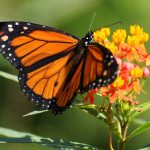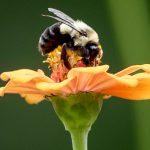Is it a pesky weed or an advantageous addition to your yard? Think twice before ridding your landscape of these broadleaf beauties.
While many people dismiss the broadleaf plants that take up residence in lawns as “weeds,” these plants can actually be desirable additions to your lawnscape. Join Cleve Powell and Brad Wier Thursday for Weed Friends and Foes, to learn about a few common weed volunteers and maybe replace disgruntlement with appreciation!
All can survive moderate mowing, produce attractive flowers and some are even host plants for butterflies:
Day flower (Commelina spp.)
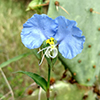 Dayflower a sparse mound of soft stems adorned with bright-blue flowers. Each bloom only lasts for a day, but as one flower fades it’s replaced by another for as long as conditions allow throughout spring and summer. Although small in stature, dayflower is valuable to wildlife; pollinators love the flowers and birds eat the seeds. I often see these plants blooming in fences or near AC condensers where they are protected from weed-eater string. If you notice a patch forming why not let it mature and flower? The soft stems won’t damage anything and can be cut back to the ground without killing the plant.
Dayflower a sparse mound of soft stems adorned with bright-blue flowers. Each bloom only lasts for a day, but as one flower fades it’s replaced by another for as long as conditions allow throughout spring and summer. Although small in stature, dayflower is valuable to wildlife; pollinators love the flowers and birds eat the seeds. I often see these plants blooming in fences or near AC condensers where they are protected from weed-eater string. If you notice a patch forming why not let it mature and flower? The soft stems won’t damage anything and can be cut back to the ground without killing the plant.
Widow’s tears (Tinantia anomala)
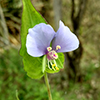 This cool season annual loves the shade of deciduous trees where other plants find it too dark to grow in the summer. It sprouts in fall and grows into what looks like a clump of grass while the leaves are off the trees. Look for the blooms of lavender that will appear on one to two-foot stems in early spring. False dayflower produces seeds and withers away before tree leaves start shading it out. The early blooms help pollinators and the seeds are eaten by birds.
This cool season annual loves the shade of deciduous trees where other plants find it too dark to grow in the summer. It sprouts in fall and grows into what looks like a clump of grass while the leaves are off the trees. Look for the blooms of lavender that will appear on one to two-foot stems in early spring. False dayflower produces seeds and withers away before tree leaves start shading it out. The early blooms help pollinators and the seeds are eaten by birds.
Wild Petunia (Ruellia nudiflora)
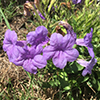 Wild petunia is a perennial I see growing intermixed in Bermuda grass lawns. Often only the leaves are visible so frequent mowing won’t kill it completely, but will prevent it from flowering. If allowed to bloom, wild petunia bears large purple or white tubular flowers that look like the petunias in your flower bed. If you notice a patch growing in a secluded part of your lawn, avoid it for a couple of mowing cycles to allow the petunias to bloom then go back to mowing as normal. Wild petunia is also the larval host plant for the common buckeye, Cuban crescentspot, fatima, Malachite and white peacock butterflies.
Wild petunia is a perennial I see growing intermixed in Bermuda grass lawns. Often only the leaves are visible so frequent mowing won’t kill it completely, but will prevent it from flowering. If allowed to bloom, wild petunia bears large purple or white tubular flowers that look like the petunias in your flower bed. If you notice a patch growing in a secluded part of your lawn, avoid it for a couple of mowing cycles to allow the petunias to bloom then go back to mowing as normal. Wild petunia is also the larval host plant for the common buckeye, Cuban crescentspot, fatima, Malachite and white peacock butterflies.
Frog fruit (Phyla incisa)
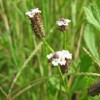 This perennial is truly lawn hardy. Frog fruit can leaf out, flower and produce seeds at a height below most lawn mower blades. Its little white flowers attract a surprising diversity of pollinators — everything from tiny sweat bees to even the largest butterflies.
This perennial is truly lawn hardy. Frog fruit can leaf out, flower and produce seeds at a height below most lawn mower blades. Its little white flowers attract a surprising diversity of pollinators — everything from tiny sweat bees to even the largest butterflies.
Swanflower (Aristolochia erecta)
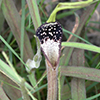 While it’s technically a vine, Swanflower has evolved to mimic grass in a vain attempt to fool mother pipevine swallowtail butterflies looking for a place to lay their eggs. Surprisingly hard to find mixed with grass, the best way to locate this drought hardy perennial is to look for either the large black butterflies or their equally impressive black and orange larvae. If you see either, you know there’s a patch of swanflower somewhere nearby.
While it’s technically a vine, Swanflower has evolved to mimic grass in a vain attempt to fool mother pipevine swallowtail butterflies looking for a place to lay their eggs. Surprisingly hard to find mixed with grass, the best way to locate this drought hardy perennial is to look for either the large black butterflies or their equally impressive black and orange larvae. If you see either, you know there’s a patch of swanflower somewhere nearby.
Rain lily (Zephyranthes sp.) Rio Grande Cooper lily (Habranthus tubispathus)
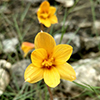 I think Rain Lilies are a great addition to any yard. Most of the time they remain dormant in the ground as a blub, just waiting. Shortly after a summer rain, they send up stems topped with one flower. The flower doesn’t last long and is soon replaced by a developing seed pod. If you have some in your yard and want them to spread, allow the seeds to mature before mowing. Rain lilies tolerate mowing well, since for much of the year they are dormant. They come in a couple of white species and one that is yellow-orange.
I think Rain Lilies are a great addition to any yard. Most of the time they remain dormant in the ground as a blub, just waiting. Shortly after a summer rain, they send up stems topped with one flower. The flower doesn’t last long and is soon replaced by a developing seed pod. If you have some in your yard and want them to spread, allow the seeds to mature before mowing. Rain lilies tolerate mowing well, since for much of the year they are dormant. They come in a couple of white species and one that is yellow-orange.
Horseherb or straggler daisy (Calyptocarpus vialis)
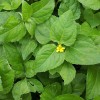 The hallmarks of straggler daisy are a mat of small hairy leaves and tiny yellow flowers. This is by far the most common lawn invader that I am asked about. It tends to look better in dappled shade. In extreme heat without water the leaves brown and curl, but never fear straggler daisy will revive itself with fall rains.
The hallmarks of straggler daisy are a mat of small hairy leaves and tiny yellow flowers. This is by far the most common lawn invader that I am asked about. It tends to look better in dappled shade. In extreme heat without water the leaves brown and curl, but never fear straggler daisy will revive itself with fall rains.
In general, a landscape meticulously composed of nothing but grass may look pristine, but it provides few resources for wildlife. Allowing a few beneficial plants to coexist with your turf makes your yard more hospitable.



